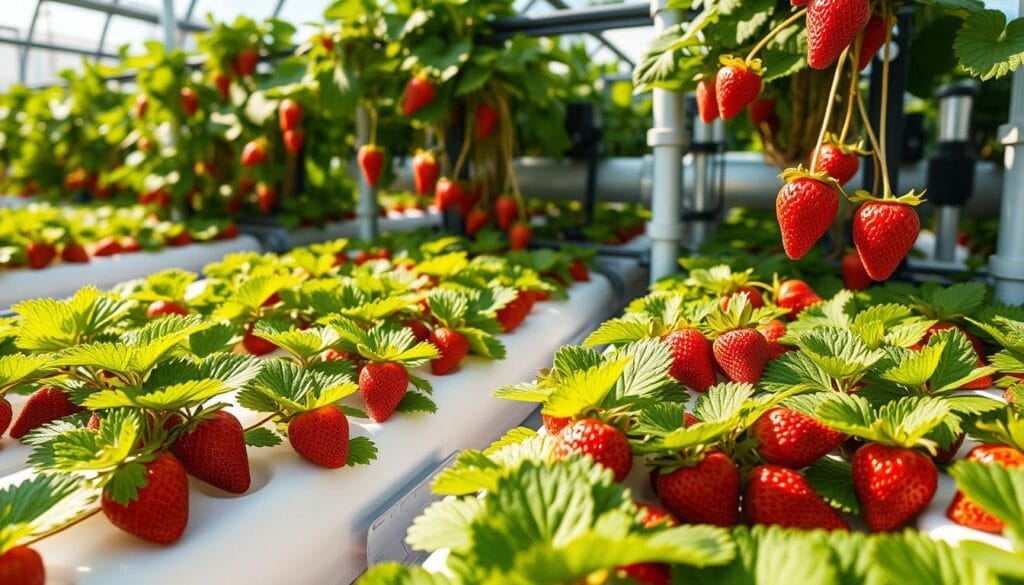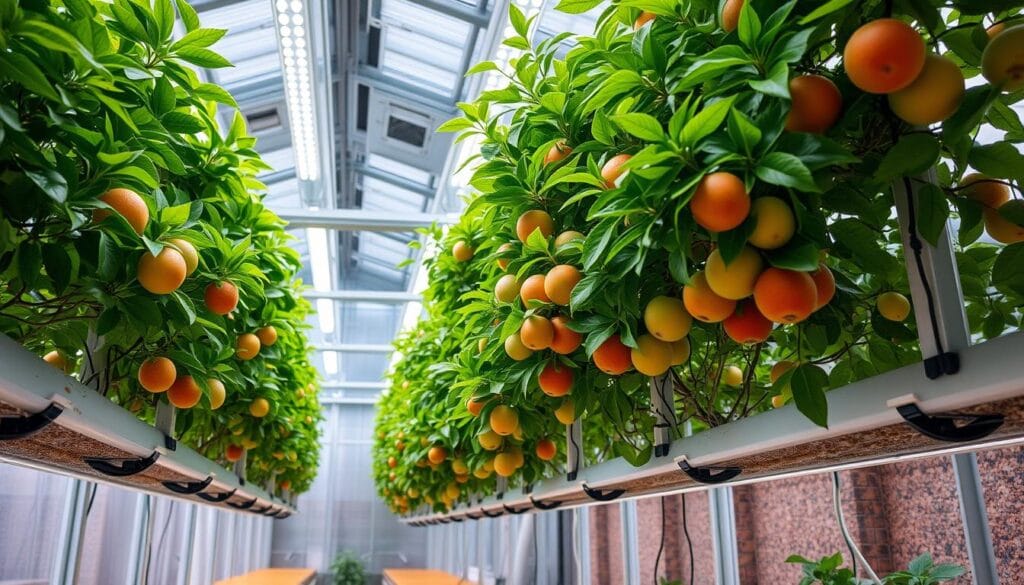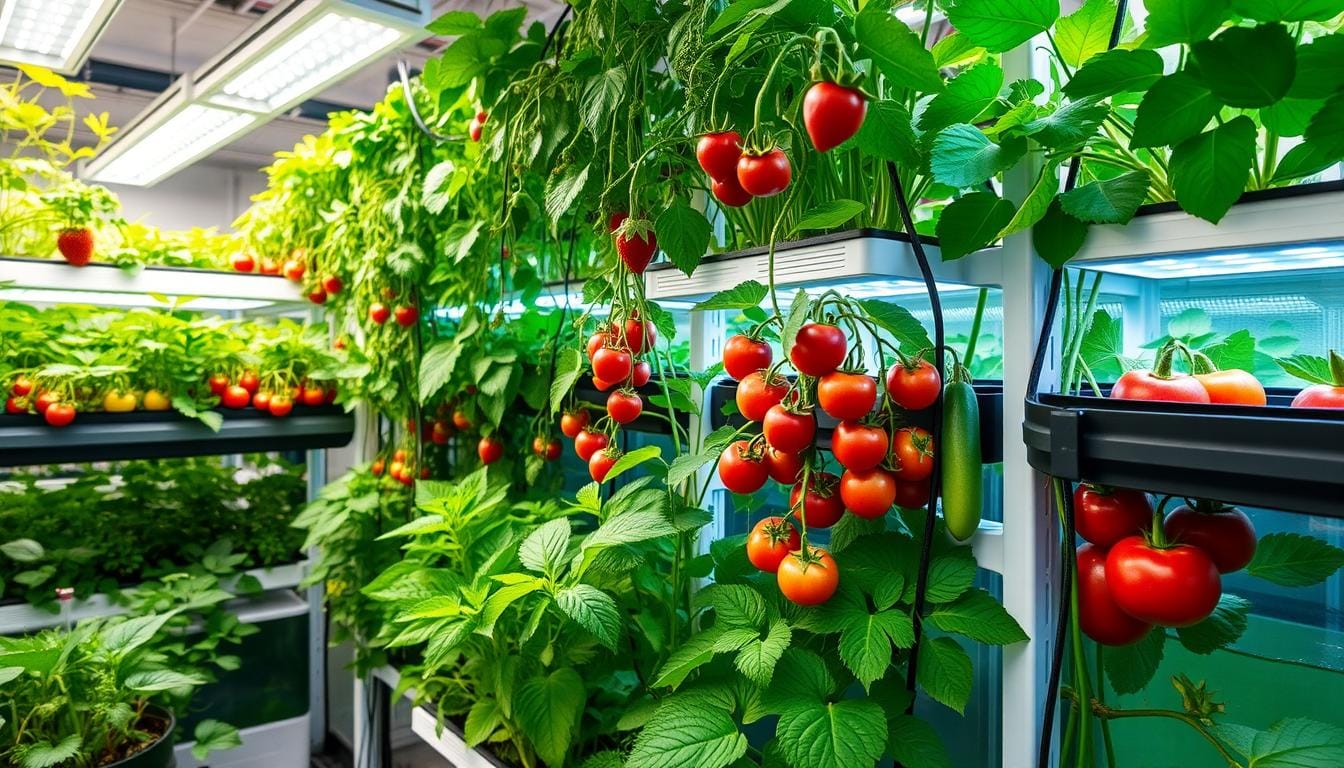Choosing the best hydroponic systems for Growing Fruit Plants at Home can feel overwhelming, especially when you’re eager to grow your own fruits and veggies in small spaces. I’ve always loved the idea of cultivating fresh produce, and hydroponic gardening caught my interest with its promise of fast growth and continuous harvests. Still, finding the perfect setup for my plants took some trial and error.
After digging into research and trying things out, I learned a lot. I found out about systems like deep water culture (DWC) and nutrient film technique (NFT). Each has its own benefits for growing a fruitful hydroponic garden.
Key Takeaways:
- Hydroponic systems grow fruits efficiently without soil, using nutrient-rich water.
- They help plants grow faster (20% increase) and produce more (25% increase) than soil gardening.
- Hydroponic fruit growing means constant harvests, exact nutrient control, and fewer pests.
- Popular fruits for hydroponic growing include strawberries, tomatoes, peppers, cucumbers, and blueberries.
- Choosing the right hydroponic system is key for successful fruit growing. Each system meets different crop needs.
Understanding Hydroponic Cultivation Basics
Hydroponic cultivation is a new way to grow plants, unlike traditional soil gardening. It uses water-based solutions to feed plants, skipping the need for soil. This method is great for growing many fruits, like hydroponic strawberry systems, hydroponic tomato systems, and hydroponic berry plants.
What Makes Hydroponics Different from Soil Growing
The main difference is how plants get their nutrients. Soil gardening relies on soil’s limited nutrients. But hydroponics lets growers control nutrients and pH levels perfectly, helping plants grow better.
Key Components of a Hydroponic System
- Reservoir: Holds the nutrient-rich water solution that feeds the plants.
- Growing Medium: Supports the plant roots and aids in nutrient and water absorption.
- Nutrient Solution: A carefully formulated blend of essential macro- and micronutrients.
- Lighting System: Provides the necessary light energy for photosynthesis.
Benefits of Hydroponic Fruit Growing
Hydroponic systems have many benefits for growing fruits. These include:
- Water Efficiency: Hydroponic gardens use up to 90% less water than traditional farming.
- Space-Saving: Hydroponic systems can be set up vertically or in small spaces, perfect for cities and small areas.
- Precise Nutrient Control: Growers can adjust nutrients to meet plant needs, improving yields and quality.
- Faster Growth Rates: Hydroponic plants grow up to twice as fast as soil-grown ones, thanks to better conditions.
By using the best hydroponic systems for growing fruit plants at home, growers can enjoy abundant harvests of sweet strawberries, juicy tomatoes, and delicious berries
Best Hydroponic Systems for Fruit Plants
There are many hydroponic systems for growing fruit plants. Each system has its own benefits. You can choose from deep water culture (DWC), nutrient film technique (NFT), and ebb and flow setups. These systems meet the needs of different fruit types.
DWC systems are great for plants like tomatoes and cucumbers. They have a lot of roots. These systems keep the water and oxygen flowing, perfect for fruits that love moisture.
For fruits like strawberries, NFT is a top choice. It brings nutrient-rich water right to the roots. This setup is great for growing lots of fruit in a small space.
- DWC systems work well for larger fruit plants with extensive root systems, such as tomatoes and cucumbers.
- NFT setups are ideal for smaller fruits like strawberries, thanks to their efficient delivery of nutrient-rich water.
- Ebb and flow systems offer versatility, accommodating a wide range of fruit plants and allowing for easy customization.
The right hydroponic system depends on the fruits you want to grow and your space. Knowing what each system offers helps you choose the best for your garden.
| Hydroponic System | Best Suited Fruit Plants | Key Advantages |
|---|---|---|
| Deep Water Culture (DWC) | Tomatoes, Cucumbers, Melons | Excellent for plants with large root systems, Constant water supply and oxygenation |
| Nutrient Film Technique (NFT) | Strawberries, Leafy Greens | Efficient delivery of nutrient-rich water, Ideal for smaller fruit plants |
| Ebb and Flow | Wide variety of fruit plants | Versatile system, Customizable for different fruit types |
“The key to successful hydroponic fruit cultivation lies in choosing the right system for your specific plant needs and available growing space.”
Deep Water Culture (DWC) Systems for Fruits
Looking to grow a vibrant hydroponic fruit garden? Choosing the Deep Water Culture (DWC) system offers significant advantages. It keeps plant roots in water full of nutrients and oxygen. This setup helps your tomatoes, berries, and other fruits grow fast and produce lots.
Setting Up a DWC System
Building a DWC system for your hydroponic plants is easy. You’ll need a reservoir, an air pump, air stones, and net pots. The VEVOR DWC system, for example, has four buckets for plants and a big reservoir bucket. Each bucket can hold up to 5 gallons of water, giving your plants plenty of room to grow.
Maintaining Optimal Water Conditions
Keeping the water just right is key for your DWC system’s success. You’ll need to check the pH, nutrient levels, and oxygen in the water often. The VEVOR system comes with an 8W air pump and four air stones. They pump 16 liters per minute of air to each bucket, helping your plants’ roots grow strong.
Best Fruits for DWC Systems
DWC systems are perfect for big fruit plants like hydroponic tomato systems and hydroponic berry plants. They love the constant flow of water full of nutrients and oxygen. The VEVOR DWC system also supports many other fruits, veggies, flowers, and herbs. It’s well-suited for use in both indoor and outdoor gardening setups.
“The DWC system’s constant supply of nutrient-rich, oxygenated water allows larger fruit plants to thrive and produce bountiful harvests.”
| Hydroponic System | Key Features | Ideal Fruits |
|---|---|---|
| Nutrient Film Technique (NFT) | Constant flow of water under plants to deliver nutrients efficiently | Leafy greens, herbs, strawberries |
| Wick Systems | Simple, no moving parts design, ideal for beginners | Herbs, smaller plants |
| Deep Water Culture (DWC) | Roots submerged in nutrient-rich water, promoting fast growth | Tomatoes, peppers, larger fruits |
| Ebb and Flow Systems | Intermittent flooding of plant roots to mimic natural watering | Wide range of fruits and vegetables |
| Aeroponic Systems | Roots suspended in air, misted with nutrients for rapid growth | Leafy greens, herbs, strawberries |
Each type of hydroponic system has unique benefits and drawbacks. Think about the space you have, your budget, and your experience level. This will help you choose the best system for growing your hydroponic tomato systems and hydroponic berry plants.
Nutrient Film Technique (NFT) for Fruit Production
The Nutrient Film Technique (NFT) is a top choice for hydroponic gardening. It’s perfect for growing many fruits. This method keeps a thin layer of nutrient-rich water flowing over the roots. This helps plants grow fast and absorb nutrients well.
NFT systems are great for small fruit plants like strawberries. They offer a controlled environment for growth. The vertical design saves space, making it ideal for indoor gardening in cities. Horizontal systems are simpler to build and popular among beginners.
The flow rate for NFT systems should be between 1/4 to 1/2 gallon per minute per channel. The slope ratio should be between 1:30 to 1:40. This ensures the nutrient solution moves properly. Channel lengths can range from a few feet to 40 feet, depending on the needs of the plants.
| Advantages of NFT Systems | Disadvantages of NFT Systems |
|---|---|
|
|
To start an NFT system, you need a few key items. These include durable channels, net cups, grow medium, a reservoir, a water pump, and air pumps if needed. With careful planning and regular upkeep, you can grow a variety of fruits efficiently.

Ebb and Flow Systems for Fruit Growing
The ebb and flow system is a top choice for growing fruits hydroponically. It works by flooding the area with nutrient-rich solution. Then, it drains the extra back into a reservoir. This lets the plants’ roots soak up what they need.
System Components and Setup
This system has a grow bed, a reservoir, a submersible pump, and a timer. The grow bed is where the plants and media live. The reservoir holds the nutrient solution. The pump and timer work together to flood and drain the bed at set times.
Ideal Fruits for Ebb and Flow
- Tomatoes
- Peppers
- Small melons
- Strawberries
- Cucumbers
This system is great for many fruits like tomatoes, peppers, and strawberries. It’s because it mimics nature’s watering cycle. This helps these plants grow well.
Maintenance Requirements
To keep the system running well, regular cleaning and checks are key. Growers need to clean the grow bed and reservoir to avoid algae and bacteria. They also must check the nutrient levels and ensure the flood and drain cycles are right.
| Component | Description |
|---|---|
| Grow Bed | Holds the growing media and plants |
| Reservoir | Stores the nutrient solution |
| Submersible Pump | Responsible for flooding and draining the grow bed |
| Timer | Controls the flooding and draining cycles |
Knowing how ebb and flow systems work helps growers grow many hydroponic fruit crops. It’s a smart and automated hydroponic system choice.
Essential Growing Media Options
Choosing the right growing media is key for indoor hydroponic gardening and growing fruit trees. The best medium supports, aerates, and holds water for plant growth. Here are some top options for hydroponic fruit cultivation:
- Rockwool is highly regarded for its ability to retain water and provide aeration. Rockwool’s structure lets roots absorb nutrients easily.
- Coco Coir: Eco-friendly and good at holding water, coco coir supports root growth. Adding perlite boosts aeration.
- Perlite: It’s all about aeration. Perlite ensures roots get enough oxygen, vital for hydroponic fruit trees.
- Clay Pebbles: These media drain well and circulate air. They’re great for systems like DWC and NFT.
The right medium depends on the fruit and system used. Each has its own benefits. Growers must think about water, air, and nutrients for the best plant growth.
| Growing Medium | Water Retention | Aeration | Nutrient Delivery |
|---|---|---|---|
| Rockwool | Excellent | Good | Efficient |
| Coco Coir | Good | Moderate | Effective |
| Perlite | Poor | Excellent | Efficient |
| Clay Pebbles | Poor | Excellent | Efficient |

“Selecting an appropriate growing medium is essential for the success of any hydroponic fruit-growing system. Each medium has its own unique properties that can significantly impact plant growth and yield.”
Nutrient Solutions and pH Management
To grow fruit plants well in hydroponics, you need the right mix of nutrients and the right pH. Getting these right is key to great growth and lots of fruit.
Essential Nutrients for Fruit Plants
Fruit plants need a mix of big nutrients and small ones. Big nutrients like nitrogen, phosphorus, and potassium help the plant grow strong and produce fruit. Small nutrients like iron, calcium, and magnesium help with photosynthesis and keeping the fruit quality high.
Growers must watch the nutrient levels closely. They adjust them to make sure the plants get what they need. The strength of the nutrient solution can vary a lot, depending on the type of fertilizer and the plant’s needs.
pH Balancing Techniques
Keeping the pH right, between 5.5 and 6.5, is very important. This guarantees that nutrients are accessible to the plant. Regular checks and adjustments with pH up or down solutions are needed to keep the system balanced.
Watching the pH closely is a big part of hydroponic fruit cultivation. Getting it right helps the best hydroponic systems for fruit plants work their best. This leads to healthy, productive plants.
| Nutrient Brand | Key Features |
|---|---|
| Canna | Renowned horticulture nutrient brand known for its high-quality, comprehensive formulas |
| Vitalink | Trusted name in the hydroponic industry, offering a wide range of nutrient solutions |
| Plant Magic | Focuses on improving soil health and promoting sustainable plant growth |
| Eco Thrive | Emphasizes eco-friendly, sustainable nutrient solutions for hydroponic systems |
| Plant Technology | Innovative nutrient formulas designed to optimize plant performance |
| OCD | Provides organic-based nutrient solutions for hydroponic growers |
| Buddhas Tree | Offers plant enhancers and nutrient supplements to support overall plant health |
“Effectively managing the nutrient solution and pH is essential for cultivating healthy fruit plants in a hydroponic system.”
Climate Control and Environmental Factors
Keeping the right climate and environment is key for indoor hydroponic gardening and growing fruit plants. Temperature, humidity, lighting, and air circulation all matter a lot. They help your automated hydroponic systems do well.
Most fruit plants like temperatures between 65°F and 75°F. Humidity should be between 50% and 70% for best growth. You’ll need 14 to 16 hours of light a day, which grow lights can provide.
Good air circulation is also important to avoid fungal problems. Fans placed right can keep air moving well around your setup. Dehumidifiers help control humidity, making a great spot for your fruit plants.
By managing these factors well, you can make a indoor hydroponic garden that grows lots of healthy fruit. Keep an eye on your climate controls. This way, your plants will get the best conditions to grow.
“Hydroponic gardens consume 90% less water than conventional farming methods, offering a sustainable and water-efficient approach to fruit production.”
Common Challenges and Troubleshooting
Hydroponic fruit cultivation has many benefits but also some challenges. Growers face issues like preventing root diseases and managing nutrient deficiencies. Keeping a hydroponic system healthy and productive needs constant attention and quick problem-solving.
Preventing Root Disease
Root diseases, like root rot and pythium, are big concerns in hydroponic fruit growing. To avoid these, it’s key to keep the system clean and well-oxygenated. Regular cleaning, proper water flow, and enough air help stop pathogens and keep roots healthy.
Managing Nutrient Deficiencies
Nutrient imbalances can cause growth problems and poor fruit quality. Growers must watch nutrient levels closely and adjust as needed. Testing the solution’s pH and EC regularly helps spot and fix any issues, ensuring plants get the right nutrients for growth and high yields.
System Maintenance Tips
- Regularly clean and maintain the hydroponic system components, such as pumps, tubing, and growing media, to prevent the buildup of algae, minerals, and other contaminants.
- Check for any leaks or blockages in the system and address them promptly to maintain proper water flow and nutrient delivery.
- Monitor water temperature and make adjustments to maintain the optimal range for your fruit plants, as temperature can significantly impact nutrient uptake and root health.
- Implement a preventative maintenance schedule to stay ahead of potential issues, such as replacing worn-out parts or calibrating sensors and monitors.
By tackling these common issues and following good maintenance practices, growers can keep their hydroponic fruit cultivation successful and productive over the long term.
Monitoring and Automation Systems
Automated hydroponic systems have changed indoor gardening a lot. They make things more efficient and precise. These systems watch over things like pH levels, nutrient amounts, temperature, and light. They do this with great accuracy.
They also have automated systems for adding nutrients and controlling the climate. This keeps your plants in the best environment for growing fruit.
Tools like EC meters and pH sensors give you real-time data. This enables you to make more informed decisions for your garden. Automation means you need less help and can get better fruit, even if you’re busy.
| Feature | Benefit |
|---|---|
| Automated Nutrient Dosing | Precise and consistent nutrient delivery for optimal plant health |
| Climate Control Systems | Maintains ideal temperature, humidity, and lighting for fruit production |
| Real-Time Monitoring | Provides data-driven insights for informed decision-making |
| Reduced Labor | Automates routine tasks, freeing up time for other gardening activities |
The LetPot Max 21-Pod Hydroponics System is a top choice for automated gardening. It costs $251.99 and has a 7.5L water tank and a 4.6-inch LED screen. It also has features like automatic water and nutrient addition, and light changes for fruits and veggies.
Whether you’re new or experienced in hydroponics, adding automation can boost your fruit yields. Technology helps you get the most out of your system. This way, you can enjoy plenty of fruit all year.
Conclusion
Hydroponic systems are great for growing fruits. They promote faster plant growth and enhance productivity. You can choose from Deep Water Culture (DWC), Nutrient Film Technique (NFT), or Ebb and Flow systems.
What you pick depends on how much space you have, the fruits you want to grow, and your experience. It’s important to manage nutrients well, control the environment, and keep your system clean.
Learning about the best hydroponic systems for growing fruits can help you create a successful garden. With the right setup and care, you can get a lot of fruit. Plus, hydroponics uses much less water than traditional farming.
Start using hydroponics to grow fruits all year round. It’s a great way to get lots of fruit, even if you’re new to growing. Hydroponics is an exciting way to grow food and can really impress you.

